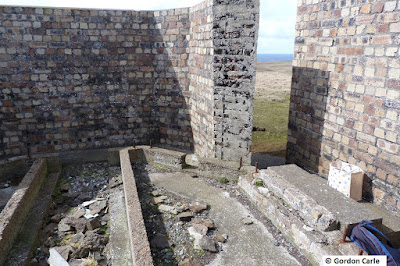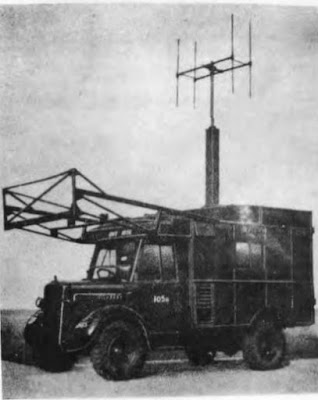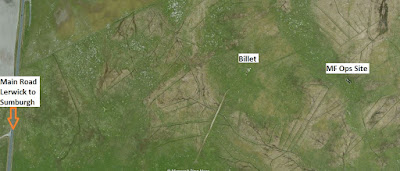I have visited 3 places in Shetland
where I believe that construction of VHF DF sites took place; at the western
end of Crussa Field on Unst, just north of Isbister on "Willies
Wart", Whalsay and at Eshaness on the Shetland Mainland. A fourth site on
the Hill of Swinister, south of Firth, also on the Shetland Mainland, was recently brought to
my attention. The Shetland sites appear to have been planned to the same design
but the first 3 I mentioned did not become operational and I don't know enough
about the site on the Hill of Swinister to make any comment on whether it
achieved active status. To begin with in this section I will
describe the remains at each location and, in succeeding paragraphs,
information from similar sites in the rest of UK will be used to attempt to
learn more about the 4 Shetland VHF DF units.
On closer inspection the raised area appears octagonal in
shape and small traces of broken glass and coal were discovered within its
boundaries. There is no solid foundation
below the 8-sided section as, when
visited, there were 2 deep rabbit holes in it. The "wall" consisted
of a coarse mixture of cement with sand and contained numbers of sea shells:
VHF D/F site near Isbister, Whasay. For two reasons it is possible to describe
this place more fully; firstly, there are more substantial remains and, more
importantly, I was fortunate enough to meet someone who was employed during the
building of the site. The construction of the operational element of the unit
took place on "Willies Wart" a small hill about 280' high, just to the
north of Isbister. A track had to be laid a distance of about half-a-mile from
the bottom of the hill. To begin with a few recent pictures of the location.
At the top of the hill, close to an historic cairn, a flat,
octagonal shaped area of concrete about 12' to 13' across at its widest point, can be seen:
At intervals around the octagonal
shaped concrete are strong but bent bolts which were possibly used to secure something:
Close to the concrete base lies a large amount of rubble. containing blocks which, from their content, look as if they were manufactured near to the
site:
A large amount of interesting information was gathered from
a few Whalsay folk. Mackie Polson was able to say that there had been 2
generators at the foot of the hill and that a cable had been laid in a ditch
alongside the track up to the site. The two "engine beds" are still
visible:
Mackie was also able to remember that there used to be the
foundations of two nissen huts close by but that they had been hidden when more
modern developments took place:
Danny Eunson was able to add the information that a Crossley
50 hp diesel generator from the site was converted to a marine engine and used
to power the fishing boat the "Bonnie Isle" when she was built at
Scalloway. George Polson, who was born in Isbister, was able to supply a lot of
useful data. When he left school in 1943 he was employed to work with the RAF personnel
who were constructing the site. George
was in the right place at the right time. He owned a Shetland pony and was
engaged to transport aggregate for the track and for the foundations at the top of
the Wart. His pay was 2s 6d (12.5p) an hour, more than many a skilled craftsman could earn in those
days.
He recalls that a wall was built around the octagonal
foundations at the top of the hill and that a 3 storey wooden hut was put up
within the wall. He thought that it was about 30' tall and a ladder was fixed
at the centre enabling ascent to the top
floor - there were windows on the top floor. He remembered being on the top
floor and dropping stones down through the opening for the ladder access. He
didn't recollect any equipment being installed before work was discontinued.
VHF DF site at Eshaness, Shetland Mainland. The
remains at this location are the most complete of the 3 Shetland sites that I have visited. An octagonal brick-built enclosure is still standing:
Outside the wall and at each corner of the octagon the stumps
of inward-sloping wooden posts can be seen:
Inside the wall extensive foundations remain:
The disturbed soil from a cable run heading north-eastwards
from the enclosure can just be traced. It leads to the foundation of what
appears to have been 2 nissen huts:
The remains of the southerly
of these huts look like it was probably for accommodation:
The other foundations are beside the current roadway - I
believe that this hut used to house generator equipment:
VHF DF site at Hill
of Swinister, Shetland Mainland. I
am grateful to Sammy Sjoberg for bringing this site to my attention. I have yet
to visit the location but intend to do so when the opportunity arises. First of
all, 2 photos sent to me by Sammy:
The Domestic
accommodation is a few hundred yards NE of the octagonal structure. Another
picture from Sammy and two pictures from Martin Briscoe:
The
following aerial photo belongs to Canmore (Royal College of Ancient and
Historical Monuments Scotland) and can be seen in it original context here
- http://canmore.org.uk/collection/1682616 :
In the
Canmore picture above the domestic site is in the foreground, whilst the
octagonal walls are just the right of the rectangular building close to the
horizon in the centre of the picture. I will update the information about this
site if more data becomes available.
Some other UK VHF D/F Sites. Some of the UK sites I have found reference to are shown below. They all seem to have/had octagonal walls, containing octagonal
concrete foundations, in common:
Saversdale,
Sanday, Orkney - http://photos.orkneycommunities.co.uk/picture/number26916.asp
Lybister, Caithness - canmore.rcahms.gov.uk/en/site/314258/contribution/lybster/
Corse Hill,
Aberdeenshire - canmore.rcahms.gov.uk/en/site/142172/contribution/corse+hill/FNL7065320649/
Scotstown Moor, Aberdeenshire
-
https://www.flickr.com/photos/doffcocker/sets/72157629563035545
Near Ronaldsway, Isle of Man - http://www.island-images.co.uk/ATC/zRon1940s/z1940s.html
Llanerchymedd, Anglesey - https://www.geograph.org.uk/photo/5408984
Llwydiarth Tower, Wales - http://trigpointing.uk/trigs/view-album.php?t=9602
Halnaker Hill in West Sussex - http://www.geograph.org.uk/photo/2969486 and https://www.youtube.com/watch?v=3vnpK1X4Od0
Garway Hill, Herefordshire - https://www.themountainguide.co.uk/england/garway-hill-photos.htm
Orfordness, Suffolk https://en.wikipedia.org/wiki/Radio_navigation#/media/File:The_%27Black_Beacon%27,_Orford_Ness_-_geograph.org.uk_-_935140.jpgNedge Hill,
Shropshire - https://www.geograph.org.uk/photo/5274112
Ibsley, Hampshire
- http://www.geograph.org.uk/photo/4704961 And
http://www.geograph.org.uk/photo/4704970
RAF Lasham,
Hampshire - https://www.geograph.org.uk/photo/5274112
Some points for
consideration.
Whilst some of the explanations with each site may vary,
they seem to have some common properties. The octagonal wall contained a 3
storey "windmill" type building 25 to 30' tall. It was wooden to
reduce the interference to radio signals and a number of descriptions refer to
an internal ladder to the upper storey, which itself had a number of windows
Some sites mention that the wooden walls were
double-skinned, the gap designed to contain stones to provide a degree of
protection from attack. The need for inward-leaning wooden stanchions, with
their bases outside the wall to support the wooden building, is also a recurring
theme. Being VHF there was no need for large antenna, each element being just a
few feet long. The next picture is from the AP2521 and shows a mobile VHF
DF unit it the '50's. However it does give a good example of the size of
antenna required:
The static sites would have had their antenna rotated by some kind of mechanism from within
the hut.
The power sources mentioned seem to be
Lister Blackstone or Crossley generators and there is some evidence that 110
volt DC power was used. Almost all the sites listed earlier are referred to as
VHF but there are variations in their assumed roles. However, the known RAF operated
sites nearly all refer to a "homing" role for friendly aircraft. The
three RAF sites in Shetland on Unst, Whalsay and at Eshaness were never
completed and I assume that was because their designed role was better
performed by more modern technology. Improved navigation systems like H2S, OBOE
and the later versions of GEE were proving to be very helpful. Certainly, RAF
heavier aircraft like the Lancaster, carried direction finding equipment which
enabled the crews to home in on signals from ground stations - at least some of
the RAF D/F units must, therefore, have been able to transmit as well as
receive - ie, they were not just "listening posts"
I am indebted to Logaston Press for allowing me to reproduce
the next picture. It is of a site similar to the three in Shetland - at Garway
Hill in Hereford - and comes from a book entitled "Garway Hill though the Ages" -
first published in 2007. The photo was taken in the mid 40's and is the best I
have seen of the type of wooden hut used on these VHF D/F sites:
Image copyright Garway Heritage Group,
taken from ‘Garway Hill through the Ages’ published by Logaston Press
The type of wooden hut must have continued in
use long after the war. This picture is from AP 2521A and shows a hut from the
early 50's, abeit with an external ladder and with the windows at a different
level:
Over the years many hundreds
of these VHF DF installations were constructed. The buildings were sometimes
octagonal, hexagonal or quadrangular. Sometimes the huts were wooden and sometimes
made of brick. Most sets were static but some mobile units were introduced. In
the RAF they became known as CRDF - Cathode Ray Direction Finding - and were
usually located on, or near, airfields. A picture of a typical 1950's RAF CRDF site:
They were used as navigation
aids and for early QGH landings. QGH was a term used to denote procedural
descents through cloud. Using the DF site and airborne radio equipment aircrew
could descend in safe areas on safe headings when the ground was obscured by
cloud layers. The systems saved many lives.
I would be
happy to hear from anyone who has more information about WWII D/F sites in
Shetland. In the meantime, I would like to acknowledge the assistance I have
received from the following sources; however, the mistakes and misconceptions
are all mine!
Acknowledgements:
Stan Ames
The late Fred Barlow
Sheila & Tim Briggs
The late Fred Barlow
Sheila & Tim Briggs
Martin Briscoe
Rita Carle
Mike Dean
Cecil Duncan
Danny Eunson
Leslie Henderson
The Late Eileen Hunter
Bob Jenner
Geordie Mainland
Mackie Polson
John Polson
Logaston Press
Whalsay Heritage (Marina Irvine)
AP2521 Chapter 4
Some WWII Direction Sites in Shetland Part 1 is
here:
https://ahistoryofrafsaxavord.blogspot.com/2019/02/some-wwii-direction-finding-sites-in.html
https://ahistoryofrafsaxavord.blogspot.com/2019/02/some-wwii-direction-finding-sites-in.html
CONTENTS LIST





























































